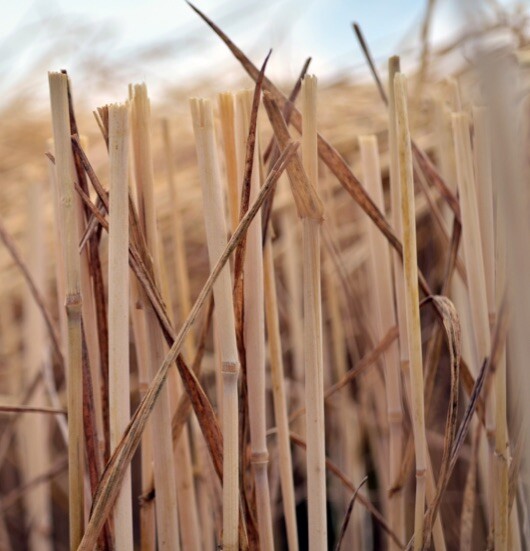The pros and cons of stubble retention
Retaining stubble can have many benefits, however, there can also be drawbacks if high stubble loads interfere with sowing and establishment the following season. This article reviews the options available to farmers managing stubble loads in the Riverine Plains.

Key messages
- Stubble retention has many benefits for soil health, can improve soil moisture and help maintain soil organic carbon levels
- Different methods of sowing and equipment have varying thresholds for the maximum stubble load that can be retained
- If full stubble retention is not feasible due to machinery, weed or disease constraints, other options such as shallow incorporation, slashing straw or cutting short at harvest can provide alternatives to burning
Retaining stubble can have many benefits, however, there can also be drawbacks if high stubble loads interfere with sowing and establishment the following season.
So what are the options available to farmers managing high stubble loads?
Benefits of stubble retention
Retaining stubble can reduce the impacts of soil erosion. Farmers should target ground cover of at least 70 per cent to minimise the water erosion risk and 50 per cent ground cover to minimise wind erosion risk. Retained stubble should have a height of at least one-third of the width of crop rows; the shelter provided by a barrier is approximately three times its height, so 10 cm tall stubble will protect the adjacent 30 cm of topsoil.
Retaining stubble can increase soil moisture content through reduced run-off and increased infiltration. Increased infiltration over summer can boost nitrogen mineralisation and availability for the subsequent crop.
Retaining stubble can also increase the input of carbon and other nutrients into the soil. Stubble is approximately 45% carbon by weight and represents a significant source of organic carbon. The amount of other nutrients returned to the soil will depend on the quality and quantity of stubble. Wheaten stubble from a high yielding crop may return up to 25 kg of available nitrogen per hectare to the soil. However, the carbon to nitrogen ratio (C:N) of stubble governs how quickly residues decompose. Pulse residues have a lower C:N ratio, so are more decomposable than wheat residues. Faster decomposition may improve nutrient availability for the following crop.
Drawbacks of stubble retention
Sowing equipment blockages are a major barrier to adoption of full stubble retained systems in southern NSW and Victoria where stubble loads are high. Traditional machinery is limited to sowing through 2-3 t/ha of cereal stubble, however slashing or harrowing can increase the capacity of machinery to move through 4-5 t/ha stubble.
Another issue for farmers sowing crops into stubble can be nitrogen tie up. As microbes break down stubble they immobolise nitrogen, which can leave crops deficient in the early growth stages. Crops sown into retained stubble may require more nitrogen during early crop growth compared to systems where stubble is not retained.
Disease carry-over in retained stubble can also be problematic. Common diseases include crown rot, take-all, yellow leaf spot, eyespot and Septoria tritici blotch in wheat, net blotch in barley and blackleg in canola. It's important to note that burning will not get rid of these diseases completely, as inoculum remains below-ground. In the case of crown rot, soil moisture loss through stubble burning may cause the disease to express itself earlier and more severely, compared to soils with a higher moisture content.
Other drawbacks of retaining stubble include higher pest populations of mice, slugs, snails, slaters, earwigs etc. Growers will need to monitor for signs of pests in spring so they can control populations early. Finding effective and efficient ways to control these pest populations is vital to ensure productivity is maintained.
Stubble management techniques
In southern NSW and Victoria, stubble is commonly burnt in autumn before sowing to improve sowing efficiency. Although retaining stubble provides benefits over the summer months, there is a period between burning and when the crop has established sufficient ground cover, when the soil surface is exposed to moisture loss and erosion.
Management of stubble should start at harvest by cutting stubble short and ensuring an even spread of chaff. If it is not possible to cut short at harvest due to time constraints, stubble can be mulched or slashed to accelerate decomposition. Another possibility is baling the straw, especially in years when demand and prices are high. Long stubble shades the emerging crop, resulting in a delay in flowering and maturity.
The inclusion of legumes and canola in the rotation can also help, as these crops produce less stubble.
Stubble management approaches should be considered strategic and flexible. Farmers will need to assess the stubble load and seasonal conditions, as it is more difficult to retain stubble following wet years or irrigated crops.
Stubble retention project
Riverine Plains carried out a five-year project on stubble retention measuring the effects of stubble on productivity. The key finding from this project were:
- Stubble management is not a key driver of yield – management should be strategic and flexible
- Long stubble shades the emerging crop, resulting in delayed flowering
- Long stubble did not significantly increase the likelihood of frost damage
Learn more about Stubble retention project outcomes or catch up on our case studies with Steve Ludeman and Denis Tomlinson
Sources/Further Reading
- School still in for residue management | Groundcover
- Managing stubble | General agronomy | Crop production | Grains, pulses and cereals | Crops and horticulture | Agriculture Victoria
- Stubble Retention in Cropping Systems in Southern Australia: Benefits and Challenges - Graham Centre (csu.edu.au)
- Benefits of Retaining Stubble - NSW | Fact Sheets | soilquality.org.au
Author
NEWS
Keep up to date with the latest news from across the Riverine Plains.
-
Livestock
-
People
-
Grains
-
Sustainability

